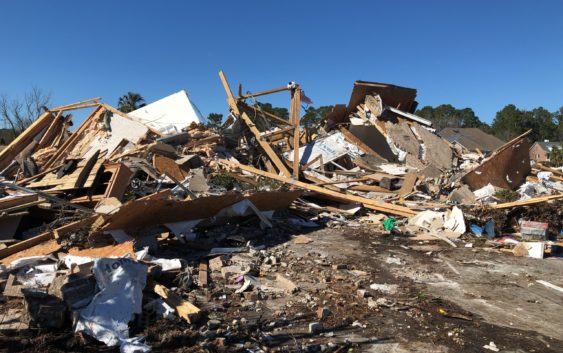- Seven months after Hurricane Helene, Chimney Rock rebuilds with resilience
- Wildfire in New Jersey Pine Barrens expected to grow before it’s contained, officials say
- Storm damage forces recovery efforts in Lancaster, Chester counties
- Evacuation orders lifted as fast-moving New Jersey wildfire burns
- Heartbreak for NC resident as wildfire reduces lifetime home to ashes
History with ‘Hud’: Remembering impactful Cape Fear tornadoes, 3 years after deadly EF3

BRUNSWICK COUNTY, NC (WWAY) — Thursday marks three years since a destructive EF3 tornado with winds of 160 miles per hour tore through parts of Brunswick County late in the evening of February 15, 2021. The twister tragically killed three people, injured 10 others and damaged or destroyed numerous homes and businesses.
While the Ocean Ridge Plantation tornado is the most recent to cause significant damage and claim lives, it’s far from the only tornado to impact the Cape Fear. While most tornadoes the region sees are weaker quick spin ups from tropical systems, there have been a handful of powerful tornadoes, too.
One of the earliest local tornadoes on record struck on April 22, 1882. An F2 tornado traveled five miles through Brunswick County’s Green Swamp before crossing the Cape Fear River into Pender County, killing one child and injuring six people. It also destroyed five homes, two sawmills, and a church.
Two more deadly tornadoes impacted Columbus County in the early 1940s. The first touched down on December 1, 1942 with the F2 tornado killing one person and injuring 30 more, moving from south of Whiteville to near Bolton. The second tornado came less than six months later, with an even stronger F3 killing one person and injuring four others northeast of Whiteville. A small but well-built four-room farm home was carried 150 yards, torn apart, and scattered across 500 yards.
More-reliable records began being kept in 1950, when another strong tornado hit.
Early in the morning of October 9, 1950, an F3 tornado struck parts of Columbus County. Three people were injures as the storm moved southwest of Lake Waccamaw. Another noteworthy Columbus County tornado made history 14 years later on October 4, 1964. A strong EF2 touched down southwest of Chadbourn, just missing the town along its staggering 54.6 mile path of damage before lifting in Pender County. Thankfully, it didn’t strike any majorly populated areas, and no one was injured or killed.
That wasn’t the case during a tornado outbreak two decades later in March of 1984. While most of the numerous F3 and F4 tornadoes remained just northwest of the Cape Fear, one F3 developed in extreme northwestern Bladen County, quickly crossing into Cumberland and Sampson County. The tornado killed one person in Bladen County, before tragically claiming eleven more lives and injuring more than 100 people as it raced at 60 miles per hour. 57 people in all were killed across North Carolina that day.
Twenty years after the major outbreak, another deadly tornado struck Pender County on August 13, 2004. The difference with this tornado was its development from Tropical Storm Bonnie. Five homes were demolished with two adults and a child being killed as a 130-mile-per-hour F2 moved along Highway 210 outside of Rocky Point.
One of the most powerful tornadoes in North Carolina history arrived to the Riegelwood community on November 16, 2006. Winds with the twister were estimated to have reached 200 miles per hour as it moved through a neighborhood off Old Lake Road, taking the lives of eight people and injuring 20 more.
A tornado outbreak rivaling the one in 1984 struck 5 years later in 2011. The April 16th string of tornadoes brought an EF2 to northern Bladen County and another towards the central region, just north of Elizabethtown. One person died in that area, with another being killed by a tornado in the northern storm, around 30 minutes before the second tornado hit.
While there hasn’t been a deadly tornado in the Cape Fear since 2021 – with no confirmed tornado touchdowns since four were reported from Tropical Storm Idalia in August of 2023 — the weather can change quickly. That’s why it’s important to have several ways to receive warnings when dangerous storms loom.
Meteorologist Matthew Huddleston (‘Hud’) has always had two major loves – weather and history. While you can watch him talk about weather each evening on WWAY, he looks forward to bringing you a little piece of history each Thursday on WWAY’s website.